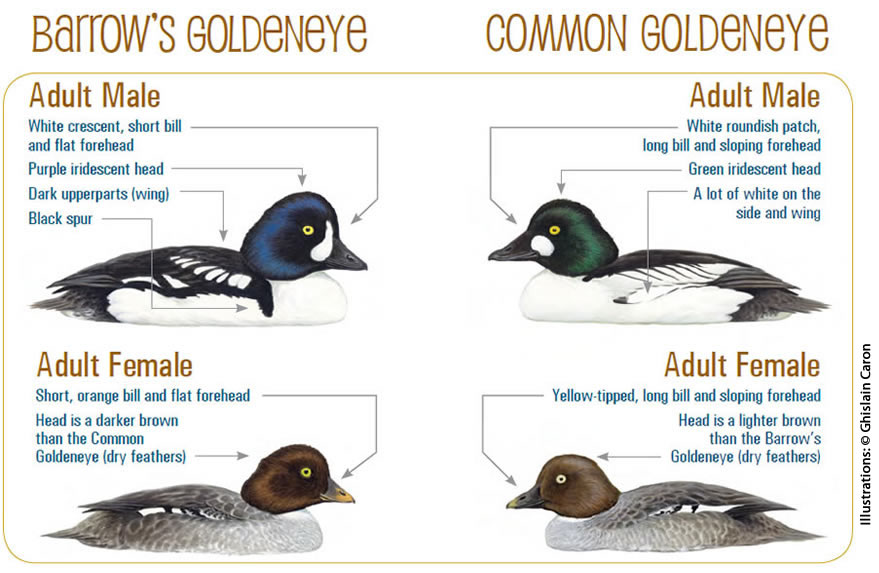Barrow's goldeneye: know how to recognize it
Warning to Hunters
The Barrow's Goldeneye looks a lot like its close relative the Common Goldeneye. These two ducks gather in Quebec, and it's important to differentiate between the two, because the Barrow's Goldeneye is "at risk" whereas the Common Goldeneye is not.

There are about 6 000 Barrow's Goldeneyes (which corresponds to 1 800 breeding pairs) in all of eastern North America. The overwhelming majority flock to Quebec - on lakes of the boreal forest in the nesting season and along the shores of the Estuary and the Gulf of St. Lawrence during the winter.
In comparison, the Common Goldeneye can be found everywhere in Quebec and throughout eastern Canada, and Quebec's boreal forest alone shelters at least 60 000 pairs. The Common Goldeneye is also found in large numbers along the St. Lawrence River during the winter.
Goldeneyes are diving ducks with a rapid wing beat that emits a characteristic whistling sound. The Barrow's Goldeneye adult male is distinguished from that of the Common Goldeneye by its darker upperparts, a black spur (patch) along its side and a white crescent on its face. The females are more difficult to tell apart, but can be recognized starting with the colour and shape of the bill and head.

Long description for Barrow's Goldeneye and Common Goldeneye
Characteristics that differentiate the Barrow's Goldeneye from the Common GoldeneyeSpeciesBarrow's GoldeneyeCommon GoldeneyeAdult MaleWhite crescent, short bill, flat foreheadPurple iridescent headDark upperparts (wing)Black spurWhite roundish patch, long bill and sloping foreheadGreen iridescent headA lot of white on the side and wingAdult FemaleShort, orange bill and flat foreheadHead is a darker brown than the Common Goldeneye (dry feathers)Yellow-tipped, long bill and sloping foreheadHead is a lighter brown than the Barrow's Goldeneye (dry feathers)
Where and when to observe them?
It's quite easy to observe the Common Goldeneye in the spring (mid-March to mid-May) and in the fall (mid-October to the end of November), when a good number of individuals gather in southern Quebec, in particular along the St. Lawrence River.
As for the Barrow's Goldeneye, it can be observed along the shores of the St. Lawrence near Charlevoix (e.g. La Malbaie, Baie-des-Rochers and Baie-Sainte-Catherine), the Quebec North Shore (e.g. Baie-Comeau), the Bas-Saint-Laurent (Lower St. Lawrence; e.g. Saint-Fabien-sur-Mer and Métis-sur-Mer) and the Gaspé Peninsula (e.g. Pointe-Saint-Pierre, baie des Chaleurs). It can be seen in all these areas from the end of October to the end of April.

Long description for Barrow's Goldeneye and Common Goldeneye
Areas where those species can be observedType of areaBarrow's GoldeneyeCommon GoldeneyeBreeding areaRepresented by a triangle with the base along the St. Lawrence River between Charlevoix and Natashquan, up to the Manicouagan ReservoirCovers all of Quebec and Ontario up to the 56th parallel north, as well as the provinces of Newfoundland and Labrador and New BrunswickWintering areaLocated exclusively along shorelines and coasts:On the North Shore of the St. Lawrence River from Natashquan to Charlevoix (including Anticosti Island)On the South Shore of the St. Lawrence River from Montmagny to the Gaspé PeninsulaAlong the coasts of the Maritime provincesA large portion of the wintering area is located in the United States. In Canada, it is located along the shoreline of the St. Lawrence River and along the coast of the Maritime provinces, as well as across Nova Scotia and Prince Edward Island
Important warning to Quebec and Atlantic hunters
Hunters who go duck-hunting near the shores of the Estuary or Gulf of St. Lawrence as well as on boreal forest lakes are likely to bag goldeneyes.
Here is information on the daily bag, possession limit and hunting season dates for the Barrow's Goldeneye
General information
You will find legal measures in provinces and territories on the Regulations Summaries web site. You may select the appropriate province or territory.

Long description for Barrow's Goldeneye and Common Goldeneye
Characteristics that differentiate the Barrow's Goldeneye from the Common GoldeneyeSpeciesBarrow's GoldeneyeCommon GoldeneyeAdult FemalesDark yellow irisShort, orange billAble to see through the nostrilsDarker brown head than the Common Goldeneye
(dry feathers)4 to 6 white feathersLight yellow irisYellow-tipped, long billNot able to see through the nostrilsLighter brown head than the Barrow's Goldeneye
(dry feathers)7 to 8 white feathersAdult MalesBlack band4 to 6 white feathers7 to 8 white feathersImmatures4 to 6 white feathers7 to 8 white feathers
The shape of nostril of the two species differs - it's possible to see through the nostrils of the Barrow's Goldeneye but not through those of the Common Goldeneye.
The distribution and extent of white feathers on the wings also help to distinguish the Barrow's Goldeneye from the Common Goldeneye.